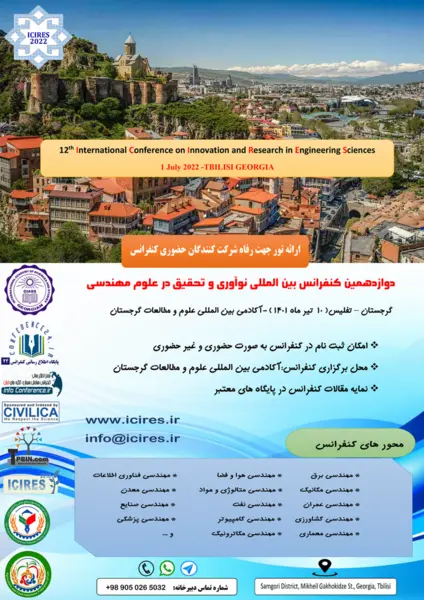-
effect of vibration amplitude at two different frequencies on the microstructure of al a356 alloy processed via vibrated cooling slope
جزئیات بیشتر مقاله- تاریخ ارائه: 1401/03/31
- تاریخ انتشار در تی پی بین: 1401/06/05
- تعداد بازدید: 199
- تعداد پرسش و پاسخ ها: 0
- شماره تماس دبیرخانه رویداد: 09050265032
effect of vibration amplitude at two different frequencies on the microstructure of al a356 alloy processed via vibrated cooling slope
cooling slope casting is one the semisolid casting methods with a simpler technology as compared with other conventional semisolid casting processes. nevertheless, this technique is a two-stage semisolid process requiring re-heating to semisolid region for gaining a globular structure. in the present study, a relatively new process, termed as vibrating cooling slope (vcs), developed at university of tehran utilized to gain a non-dendritic globular structure in a356 al alloy.
in this technique, the conventional cooling slope and vibration casting methods have been combined into an integrated one for producing globular structures in the as-cast condition. the effect of the vibration amplitude in the range of 120 to 800μm at two different vibration frequencies of 40 and 60 hz on the morphology of specimens examined. the microstructure of the sample produced at the amplitude of 120 μm and frequency of 40 hz was not globular but after reheating turned to globular.
however, the sample produced by vcs at the amplitude of 120 μm and frequency of 60 hz as well as the samples processed at the amplitude of 400μm and 800μm at both frequencies of 40 hz and 60 hz exhibited a globular structure in the as-cast condition. in addition, increasing the vibration amplitude from 120 to 800μm resulted in decreased size of globules for both applied frequencies.
also, the shape factor of globules increased with increasing the amplitude of vibration in the range of 120 to 400 μm, but remained almost constant for further increase of this parameter. the increased vibration frequency resulted in a smaller globule size and a larger shape factor for all of the explored amplitudes.
the microstructural analysis revealed that the optimum microstructure (from the point of view of the size and morphology of globules) achieved at the vibration amplitude of 800 μm and frequency of 60 hz. these results attributed to increased amount of the shear stress imposed on the semisolid alloy on the cooling slope by increased amplitude and frequency of the applied vibration.
مقالات جدیدترین رویدادها
-
استفاده از تحلیل اهمیت-عملکرد در ارائه الگوی مدیریت خلاقیت سازمانی و ارائه راهکار جهت بهبود
-
بررسی تاثیر ارزش وجوه نقد مازاد بر ساختار سرمایه شرکت های پذیرفته شده در بورس اوراق بهادار تهران
-
بررسی تأثیر سطح افشای ریسک بر قرارداد بدهی شرکت های پذیرفته شده در بورس اوراق بهادار تهران
-
بررسی تأثیر رتبه بندی اعتباری مبتنی بر مدل امتیاز بازار نوظهور بر نقد شوندگی سهام با تأکید بر خصوصی سازی شرکت ها
-
تأثیر آمیخته بازاریابی پوشاک ایرانی بر تصویر ذهنی مشتری پوشاک ایرانی (هاکوپیان)
-
بررسی رفتار ساختمان های بتن آرمه بهسازی شده با دیوارهای برشی آلومینیومی
-
ارزیابی درجه تراکم دانه بندی گسسته و پیوسته سنگدانه ها در حالت دو بعدی
-
بررسی طراحی بهینه و عملکرد لرزه ای میراگرهای ویسکوز الحاقی در نواحی زلزله خیز
-
طرح دعاوی خصوصی از نظر ضمان قهری و ضررو زیان وارد در دادگاه های عمومی
-
بررسی نحوه طراحی و رتبه بندی سایت در سامانه leed و breeam و امکان سنجی آن با مقررات ملی ساختمان در ایران
مقالات جدیدترین ژورنال ها
-
مدیریت و بررسی افسردگی دانش آموزان دختر مقطع متوسطه دوم در دروان کرونا در شهرستان دزفول
-
مدیریت و بررسی خرد سیاسی در اندیشه ی فردوسی در ادب ایران
-
واکاوی و مدیریت توصیفی قلمدان(جاکلیدی)ضریح در موزه آستان قدس رضوی
-
بررسی تاثیر خلاقیت، دانش و انگیزه کارکنان بر پیشنهادات نوآورانه کارکنان ( مورد مطالعه: هتل های 3 و 4 ستاره استان کرمان)
-
بررسی تاثیر کیفیت سیستم های اطلاعاتی بر تصمیم گیری موفق در شرکتهای تولیدی استان اصفهان (مورد مطالعه: مدیران شرکتهای تولیدی استان اصفهان)
-
نقش صله رحم در سلامت جسمی و روحی خانواده با تمرکز بر گزاره های اسلامی
-
بررسی تاثیر یارانه سفر بر توسعه گردشگری؛ مطالعه موردی: گردشگران شهر مشهد مقدس
-
evaluate the use of recycled asphalt pavement (rap) in the construction of roller compacted concret pavement (rcc)
-
the transformation of aesthetics in architecture from traditional to modern architecture: a case study of the yoruba (southwestern) region of nigeria
-
exploring in silico drug design and pharmacokinetics study for identification of potent antidepressant agents




سوال خود را در مورد این مقاله مطرح نمایید :